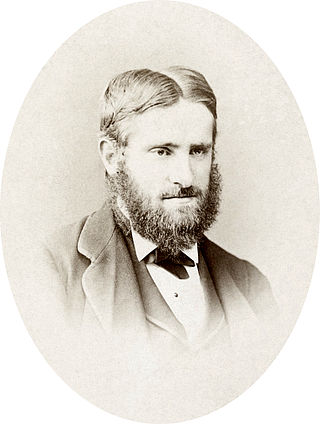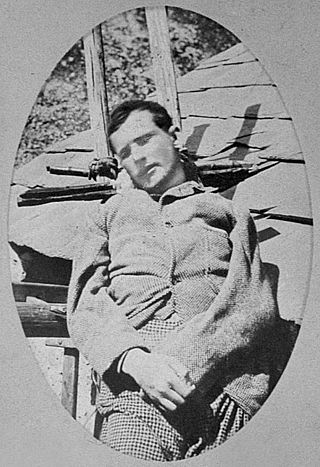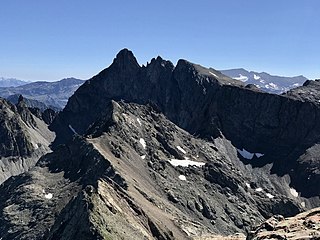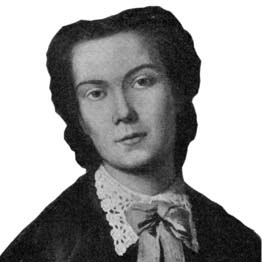
Hautes-Alpes is a department in the Provence-Alpes-Côte d'Azur region of Southeastern France. It is located in the heart of the French Alps, after which it is named. Hautes-Alpes had a population of 141,220 as of 2019, which makes it the third least populated French department. Its prefecture is Gap; its sole subprefecture is Briançon. Its INSEE and postal code is 05.

Isère is a landlocked department in the southeastern French region of Auvergne-Rhône-Alpes. Named after the river Isère, it had a population of 1,271,166 in 2019. Its prefecture is Grenoble. It borders Rhône to the northwest, Ain to the north, Savoie to the east, Hautes-Alpes to the south, Drôme and Ardèche to the southwest and Loire to the west.

La Meije is a mountain in the Massif des Écrins range, located at the border of the Hautes-Alpes and Isère départements. It overlooks the nearby village of La Grave, a mountaineering centre and ski resort, well known for its off-piste and extreme skiing possibilities, and also dominates the view west of the Col du Lautaret. It is the second highest mountain of the Écrins after the Barre des Écrins.

The Barre des Écrins is a mountain in the French Alps with a peak elevation of 4,102 metres (13,458 ft). It is the highest peak of the Massif des Écrins and the Dauphiné Alps and the most southerly alpine peak in Europe that is higher than 4,000 metres. It is the only 4,000-metre mountain in France that lies outside the Mont Blanc Massif. Before the annexation of Savoy in 1860 it was the highest mountain in France.

Belledonne is a mountain range in the Dauphiné Alps in southeast France. The southern end of the range forms the eastern wall of the mountains that surround the city of Grenoble.
Sarah Katharine "Katy" Richardson, also referred to as Kathleen Richardson, was a British mountain climber. She made numerous first ascents in the Alps and climbed frequently with her close friend Mary Paillon.

The Ailefroide is a mountain in the Massif des Écrins in the French Alps, and is the third highest peak in the Dauphiné Alps after the Barre des Écrins and La Meije. It lies at the south-western end of the Mont Pelvoux–Pic Sans Nom–Ailefroide ridge.
The silver age of alpinism is the name given in the United Kingdom to the era in mountaineering that began after Edward Whymper and party's ascent of the Matterhorn in 1865 and ended with W. W. Graham and party's ascent of the Dent du Géant in 1882.

The Lautaret Alpine Garden is an alpine botanical garden located at 2100 metres altitude in the Col du Lautaret of the Dauphiné Alps, near Villar-d'Arêne, Hautes-Alpes, Provence-Alpes-Côte d'Azur, France. It is part of the List of Remarkable Gardens of France certified by the Ministry of Culture (France).

William Augustus Brevoort Coolidge was an American historian, theologian and mountaineer.

The Musée dauphinois, located in Grenoble (France), is dedicated to the ethnography, archaeology, history and society of the former province of the Dauphiné. Situated above the neighbourhood of Saint-Laurent in the listed historic monument of Sainte-Marie d’en-Haut, the Musée dauphinois is an accredited “Musée de France“ and takes part in the Long Night of Museums.

Pic Gaspard is a mountain in the French Alps, one of the tallest in the Massif des Écrins. It was named in honor of the celebrated L'Oisans guide Pierre Gaspard, conqueror of La Meije on 16 August 1877 in the company of Emmanuel Boileau de Castelnau.

L'Oisans is a region in the French Alps, located in the départements of l'Isère and Hautes-Alpes, and corresponding to the drainage basin of the River Romanche and its tributaries. Between Livet-et-Gavet and Le Bourg-d'Oisans, the Romanche forms a deep gorge.

Henri Cordier or Henry Cordier was a French mountaineer. In his short two-year career, he became the first Frenchman to reach the level of the English members of the Alpine Club, in the silver age of alpinism in the second half of the 19th century, which was dominated by the development of mountaineering in the Alps. With some of the Alpine Club's mountain guides and mountaineers, he led significant first ascents in the Mont Blanc massif and in the Dauphiné Alps.

Henri Emmanuel Boileau, baron de Castelnau (1857-1923) was a French alpinist and sportsman who took part in the first ascent of the Meije. After his career as an alpinist he competed as an amateur cyclist.

Pierre Gaspard was a French mountain climber, one of the greatest mountain guides in the silver age of alpinism. He made the first ascent of La Meije on 16 August 1877 with his son and Emmanuel Boileau de Castelnau. Their ascent followed the south buttress Arête du Promontoire, which became the "normal route".

Croix de Belledonne, at 2,926 metres (9,600 ft), is one of the highest points in the Belledonne range in the French Alps, close to the highest summit in the range, Grand Pic de Belledonne at 2,977 metres (9,767 ft). The name derives from the cross erected on the summit.

Mary Paillon (1848–1946) was a French mountain climber and writer. She is known for her climbs with Katharine Richardson, and for her contribution to the Alpine Journal and the Ladies' Alpine Club.

Louise Drevet, née Marie-Louise Chaffanel was a French novelist. She was co-founder, editor and contributor to newspaper Le Dauphiné.

Ulrich Almer was a Swiss mountain guide, born on 8 May 1849 in Grindelwald where he died on 4 September 1940. He made many premieres in the Alps, at the beginning with his father Christian Almer, one of the great guides of the golden age of mountaineering, and was one of the first Swiss guides to visit the Caucasus.


















